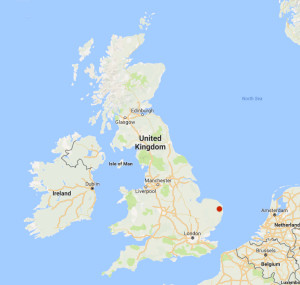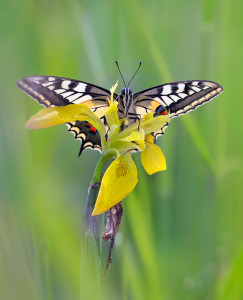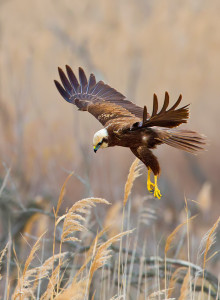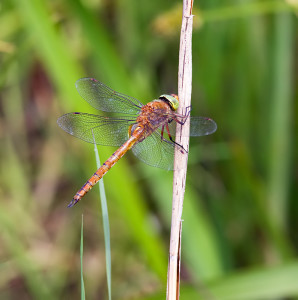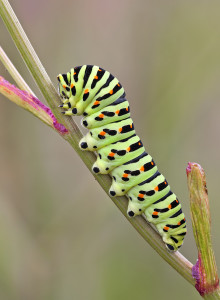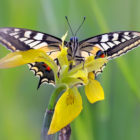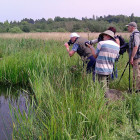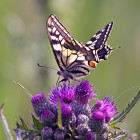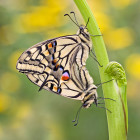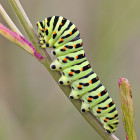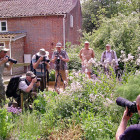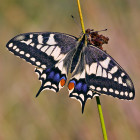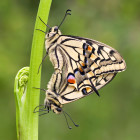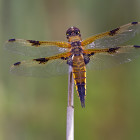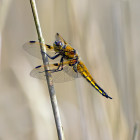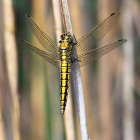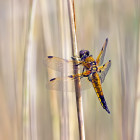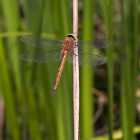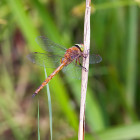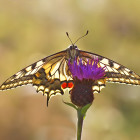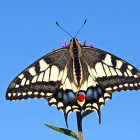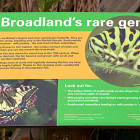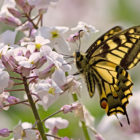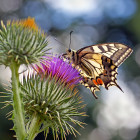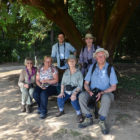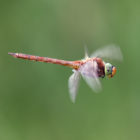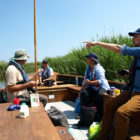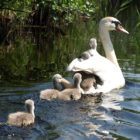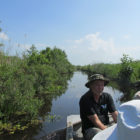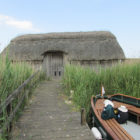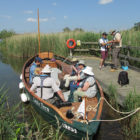Dates & Prices |
BOOK NOW |
Dates: 6th – 9th June 2025 Confirmed departure
Price: £995 1 place available
Single Supplement: £95
Deposit: £150 per person
Price Includes: All meals, accommodation, local transport, services of the guides, evening talk, holiday report
Not Included: International travel, travel insurance, drinks & any other personal items
Conservation Donation: Butterfly Conservation Europe
Leader: Patrick Barkham (co-leader TBC)
Group Size: Minimum of 4 and a maximum of 12 guests plus 1-2 leaders.
Grade: Gentle pace. Ideally suited to photography
Holiday Highlights
- Explore the Norfolk Broads for the iconic & beautiful British Swallowtail
- Led by Patrick Barkham, author of The Butterfly Isles
- Great chance to spend time observing and photographing the British Swallowtail in its only natural habitat in the country
- Electric ‘Swallowtail Safari’ boat trip on one of the Broads
- Patrick will also give an entertaining evening talk “The Wonders of Butterflies”
- Visit numerous nature reserves and broads to get a real taste of the areas unique and wonderful habitats
- Other great wildlife to enjoy such as Norfolk Hawker dragonfly, Fen & other Orchids, Milk Parsley, Marsh Harrier, Bittern, Bearded Tit and much more
- At least one moth trapping session to open & view a previous nights catch
- In support of Butterfly Conservation
 Holiday Guide
Holiday Guide

Patrick Barkham is Natural History Writer for the Guardian and the author of The Butterfly Isles.
An enthusiastic amateur naturalist, Patrick was born in Norfolk and was educated at Cambridge University. He developed a passion for butterflies as an eight-year-old searching for the Brown Argus but only completed his boyhood mission in 2009, when he saw all 59 species of British butterfly in one summer and wrote a book about it.
His second book, Badgerlands, was hailed by Chris Packham as “a must read for all Britain’s naturalists”. His recent book, Coastlines, a history of coastal conservation, was praised by Blake Morrison as “an informative, enthusiastic and at times rapturous celebration of our shores”. His latest book, Islander, is about the human and non-human residents of Britain’s small isles.
He lives in the land of the Swallowtail with his three young children and is very proud of his four-year-old twins for being able to distinguish a Peacock from a Painted Lady at 100 yards. In 2012 he received The Marsh Christian Trust Award for the Promotion of Lepidoptera Conservation from Butterfly Conservation.
The Norfolk Broads has more miles of waterway than the famous Italian city, over 125 miles, so although perhaps a little less romantic it is in fact a fantastic water world of its own, full of big skies and a sparkling landscape of marshland fields, feathery reeds and tangled woodlands. It is the perfect canvas for adventure and relaxation – time to reflect and space to explore. This break provides you with a unique opportunity to enjoy this wonderful landscape with Patrick Barkham who loves this ‘land of the Swallowtail’ which he calls home! The Broads boast booming Bitterns, playful otters and darting Kingfishers, native white waterlilies and rare fen orchids. It is also the only place to see the rare and beautiful Swallowtail, which is the species we’ll dedicate significant time to during our stay. Our plan is to visit several of the best sites in the area to see Swallowtails. They include Strumpshaw Fen (RSPB reserve), Hickling Broad (Norfolk Wildlife Trust), How Hill (How Hill Trust), Wheatfen (Ted Ellis Trust Reserve) and Catfield Fen (Butterfly Conservation reserve managed in partnership with RSPB). We should (depending on weather and the season) get to see plenty of Swallowtail activity and plenty of other wildlife too! We may also visit one or two more secret and off the beaten track places and hope to arrange some special access (by boat) to some harder to reach locations. A boat trip is also a fantastic way to experience the Broads, being afloat becomes a real adventure, with hidden places and close encounters with wildlife at every turn. We won’t only look for Swallowtails of course! Another fairly iconic species itself that we’ll want to show you is the Norfolk Hawker dragonfly with its distinctive green eyes (which give it its alternative name the Green-eyed Hawker) and we should get to see these beautiful insects on the wing during our days out. We’ll see numerous other dragonfly species too, such as Banded Demoiselle and Four-spotted Chaser. We should also enjoy the chorus of booming bitterns, the almost impossibly loud series of notes of Cetti’s Warblers (as if someone is shouting to attract your attention) and Cuckoos calling – all combining to form a delightful soundtrack to our ‘Swallowtail days’! We’ll also hope to enjoy good views of Marsh Harriers over the reed beds, these handsome hawks are easy to identify as they hang in the air above the reed and sedge beds, quartering the acres of their territories on long, broad wings. As we focus our ears and eyes closer we may be lucky enough to see Bearded Tits too. Plants are also of interest in the Broads and there are numerous species of local interest. For example, Milk Parsley, the food plant of the Swallowtail and almost as rare as the butterfly itself! We’ll search its feathery foliage for freshly laid Swallowtail eggs or the black (bird poo) young instar caterpillars, some may also be more advanced and the funky green stripey version! We may get to see one of the few colonies of Fen Orchid remaining in the UK too. Other plants of note include Marsh Fern, Cowbane, Greater Water-parsnip, Greater Spearwort and Marsh-pea. Bisecting the fens and grazing marshes the cleaner dykes also support a varied and interesting flora, with Frogbit, Arrowhead, Greater Bladderwort, Water Soldier, and Fringed, Yellow and White Water-lilies all being present. What Are The Norfolk Broads? An internationally important wetland, the Broads is a member of the National Park family, and includes some of Europe’s most special nature reserves, with no fewer than 28 Sites of Special Scientific Interest. The Norfolk Broads, once a vast estuary, are a series of rivers and broads (lakes), most of which are navigable. The square area of the Norfolk Broads totals 303 kilometres, most of this is in the County of Norfolk, and just over 200 square kilometres of these waterways are navigable, covering seven rivers and 63 Broads. The depth of these waterways is usually less than 4 metres deep. Thirteen of the broads are completely navigable whilst three others have channels open to navigation running through them. The Broads range from small ponds through the large areas such as Hickling, Barton and Breydon. The majority are located in the northern half of Broadland which encompass the Rivers, Bure, Ant and Thurne. Central and Southern parts of Broadland encompass the Rivers Waveney, Yare and Chet, however all the waterways are tidal but the effect of the tide decreases the further away from the coast until reaches upstream from Barton Broad are almost non tidal. Information about some of the sites we’ll visit The RSPB’s reserve at Strumpshaw Fen is in the heart of the Norfolk Broads. A number of nature trails lead you through the varied habitats, including reedbeds and woodland and in the summer Strumpshaw is the perfect place to enjoy Broadland meadow flowers. Set in the wild and beautiful Yare Valley, near Norwich, Strumpshaw Fen is an enchanting nature reserve where you can get close to the outstanding wildlife of the Norfolk Broads. Enjoy a gentle family stroll through a timeless landscape of reedbeds, pools, meadows and woodlands. In spring and summer, the meadows bloom with wild orchids and come alive with dragonflies and butterflies. Look out for rare insects like swallowtail butterflies and Norfolk hawker dragonflies. The Catfield Fen reserve is part of the Ant Broads and Marshes National Nature Reserve (NNR), which covers much of the floodplain of the middle Ant Valley. The NNR is one of the best and largest remaining areas of fen habitat in Western Europe. Known as the ‘jewel in the crown’ of the Norfolk Broads, frankly, there is nowhere else quite like it. Catfield Fen has been cut for reed and sedge for thatching for many years. Butterfly Conservation (BC) purchased the reserve in 1992 and has managed it ever since, with the RSPB since 2012. The reserve is a typical fen mixture of open water, reed, sedge and carr woodland. The reed is cut on a 1–2 year cycle and sedge, on a 3–5 year cycle. This is used for thatching, and produces an ideal range of vegetation structures for a great diversity of wildlife. Many uncommon and rare plants and animals are found on the reserve, including Milk Parsley and Crested Buckler Fern, and dragonflies such as the Norfolk Hawker. The dykes and ditches support rare plants such as Frogbit and stoneworts. Old peat cuttings on the reserve provide a special range of conditions for water beetles and Catfield Fen is one of the top national sites for them. The reserve is also the only site from which Trogus lapidator, the Ichneumonid wasp parasite of the Swallowtail, has been recorded in the UK. As well as providing a home to the rare Swallowtail Butterfly, it also supports a community of endangered fen orchids (Liparis loeselii) and other wild flowers. The How Hill Trust is a renowned environmental educational charity, established in 1984. It is based in the landmark How Hill House overlooking beautiful gardens, wetlands, historic windmills, woodlands and the river Ant. Next to the staithe and not far from the house is Toad Hole cottage. The cottage is preserved as a museum and shows the life of a marshman living and working in this area. This is where the nature trail starts from and is a good trail in early summer to see the swallowtails. How Hill house was built 100 years ago as a holiday home for the family of Edward Boardman, an architect from Norwich. It is built on the hill and has an excellent view over Turf Fen and the River Ant. The gardens that surround the house belong to the Broads Authority and are open all the year round to the public. The largest of the Broads, Norfolk Wildlife Trusts (NWT) Hickling Broad is a year-round haven for wildlife. It is easy to spend a day walking around its trails or, in summer, gently whiling away a couple of hours taking in the Broad’s hidden corners on one of NWT’s boat tours. Hickling is situated on the Upper Thurne river system, which holds a significant percentage of the UK population of common crane as well as important breeding numbers of bittern, marsh harrier bearded tit and Cetti’s warbler. In winter large numbers of marsh harriers roost in the reedbed north east of Stubb Mill; merlin and hen harrier are also regular. Barn owl is almost guaranteed and you may see kingfisher if you are lucky. Interesting mammals include the introduced Chinese water deer, red deer and hard-to-see otters. Among the many insects are two iconic local specialities – the swallowtail butterfly and the Norfolk hawker dragonfly – though many equally rare, albeit lesser-known, invertebrates also occur. Plants are well-represented, with the important milk parsley: the larval food plant of the swallowtail. Wheatfen Broad is one of the few remaining areas of the once extensive Yare Valley swamp. It is, undoubtedly, one of the most important sites of its kind in Britain. As the patron of the Trust, David Bellamy said, “Wheatfen Broad is, in its way, as important as Mount Everest or the giant redwood forests of North America. It is probably the best bit of fenland we have because we know so much about it. That is purely because one man gave his life trying to understand it – Ted Ellis”. Wheatfen is now managed as a nature reserve and consists largely of open fen, reed beds, sallow carr and the small broads Wheatfen and Deep Waters. The house and adjacent land are still owned by the family who permit The Trust to extend the nature trails into Surlingham Wood and The Carr. This is a strange primitive area recognised as a Site of Special Scientific Interest and is one of the last tidal marshes of the Yare Valley. The Trust wants to preserve its rich and fragile ecology, but above all, it wants to keep this land and its wildlife accessible for the enjoyment and education of children, students and everyone interested in Nature.Strumpshaw Fen
Catfield Fen
How Hill
Hickling Broad
Wheatfen
Day 1: Meet at the Hotel in the afternoon. First local excursion if time permits and evening meal.
Day 2: Exploration of local area. Packed lunch, evening meal at hotel or outside.
Day 3: Exploration of local area. Packed lunch, evening meal at hotel or outside
Day 4: Morning of moths with Patrick in his own wildlife garden, followed by departures between 11am – 12noon.
Phil B, June 2017: This was my first experience with Greenwings after doing many trips with other company’s. I was impressed with the ease of booking and communication between us and the office. I liked the relaxed attitude of Patrick, we weren’t being rushed from A to B, if we wanted to stay at one site a little longer then no problem. I also thought the idea of eating out of the hotel one evening was excellent, although the hotel food was pretty good.
Norfolk Swallowtail Weekend 11th – 14th June 2021 Holiday Report
Norfolk Swallowtails 8th – 11th June 2021 Holiday Report
Norfolk Swallowtail Weekend 4th – 7th June 2021 Holiday Report
Norfolk Swallowtail Weekend Holiday Report 14th – 17th June 2019
Norfolk Swallowtail Weekend Holiday Report 7th – 10th June 2019
Norfolk Swallowtail Weekend Holiday Report 15th – 18th June 2018


